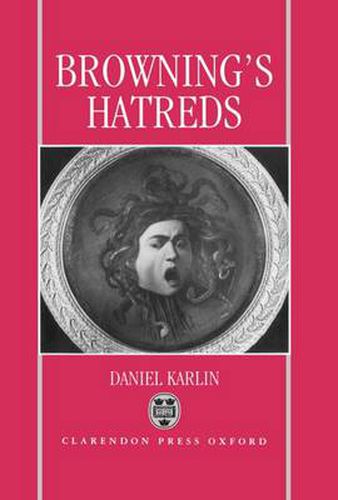Readings Newsletter
Become a Readings Member to make your shopping experience even easier.
Sign in or sign up for free!
You’re not far away from qualifying for FREE standard shipping within Australia
You’ve qualified for FREE standard shipping within Australia
The cart is loading…






Gr-r-r–there go, my heart’s abhorrence! Water your damned flower-pots, do! If hate killed men, Brother Lawrence, God’s blood, would not mine kill you!
The bitter and twisted monk of “Soliloquy of the Spanish Cloister’ is Browning’s best-known hater, but hatred was a topic to which he returned again and again in both letters and poems. Daniel Karlin has written a perceptive and original study of Browning’s hatreds, and their influence on his poetry. Browning was himself a "good hater’, and Karlin analyses his hatreds of figures such as Wordsworth (the model for his "Lost Leader’), and more generally, tyranny and the abuse of power, and deceit or quackery in personal relationships or intellectual systems. Tracing the subtlest windings and branchings of Browning’s idea of hatred through detailed discussion of key poems, the author shows how Browning’s work displays an unequalled grasp of hatred as a personal emotion, as an intellectual principle, and as a source of artistic creativity. Particular attention is devoted to Browning’s compulsive and compelling exploration of the duality of love and hate.
$9.00 standard shipping within Australia
FREE standard shipping within Australia for orders over $100.00
Express & International shipping calculated at checkout
Gr-r-r–there go, my heart’s abhorrence! Water your damned flower-pots, do! If hate killed men, Brother Lawrence, God’s blood, would not mine kill you!
The bitter and twisted monk of “Soliloquy of the Spanish Cloister’ is Browning’s best-known hater, but hatred was a topic to which he returned again and again in both letters and poems. Daniel Karlin has written a perceptive and original study of Browning’s hatreds, and their influence on his poetry. Browning was himself a "good hater’, and Karlin analyses his hatreds of figures such as Wordsworth (the model for his "Lost Leader’), and more generally, tyranny and the abuse of power, and deceit or quackery in personal relationships or intellectual systems. Tracing the subtlest windings and branchings of Browning’s idea of hatred through detailed discussion of key poems, the author shows how Browning’s work displays an unequalled grasp of hatred as a personal emotion, as an intellectual principle, and as a source of artistic creativity. Particular attention is devoted to Browning’s compulsive and compelling exploration of the duality of love and hate.